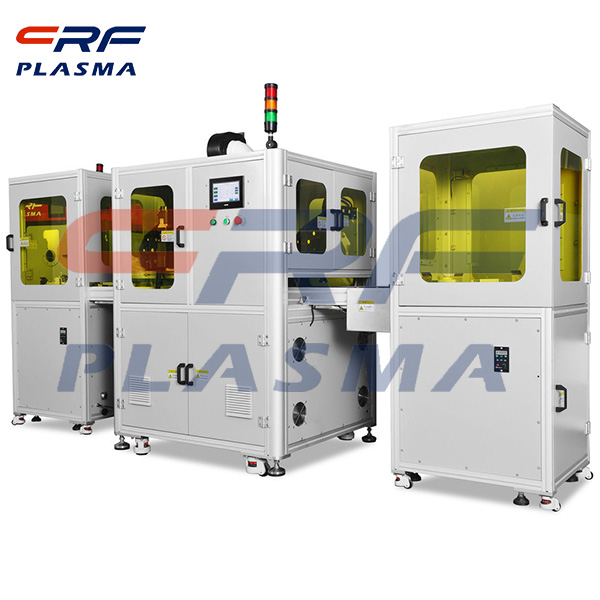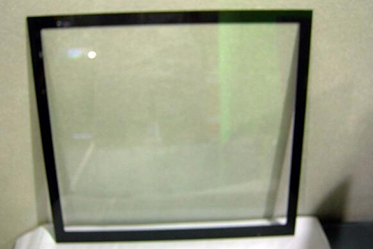
Welcome to Shenzhen Sing Fung Intelligent Manufacturing Co., Ltd.
E-mail:shaobo@sfi-crf.com
Characteristics of plasma dry etching technology and typical material applications
- Categories:Technical Support
- Author:plasma cleaning machine-surface treatment equipment-CRF plasma machine-Sing Fung Intelligent Manufacturing
- Origin:
- Time of issue:2021-02-03
- Views:
(Summary description)Plasma etching machine is also known as plasma etching machine, plasma plane etching machine, plasma surface treatment instrument, plasma cleaning system, etc. Plasma etching, is a common form of dry etching, its principle is exposed to the electronic area gas plasma, the plasma and the release of high-energy electron gas, forming a plasma or ion, when the plasma atomic accelerated by electric field can release enough force to close to the material or surface of etching, which combined with surface driving force. Plasma cleaning is actually a slight phenomenon in the process of plasma etching to some extent. Dry etching equipment includes reaction chamber, power supply, vacuum, etc. The working parts are sent to the reaction chamber, where the gases are introduced into the plasma and exchanged. Plasma etching process is essentially an active plasma process. More recently, in the reaction room there is a downstream format that will play a flexible role and users will move around to configure appropriate plasma etching methods: RIE, downstream plasma, direction plasma. Inductively coupled plasma etching (ICPE) is the result of chemical and physical processes. Whose basic principle is: under the pressure, the RF power supply to the loop coupling coil output by ICP, coupled by glow discharge, mixed etching gas glow discharge by coupling, to produce high density plasma, the electrode under the action of RF, bombarding the substrate surface, substrate semiconductor materials of chemical bonds in graphic area is interrupted, and etching gas to produce volatile substances, gas out of the substrate, the vacuum tube to pull away. For etching, and after etching for decontamination, scum removal, surface treatment, plasma polymerization, plasma ash or any other etching applications, we can produce safe and reliable plasma treatment systems according to customer requirements. The company has both traditional plasma etching system and reactive ion etching system, can produce a series of products, also can customize the special system for customers. Our company can provide fast/high quality etching, reduce plasma damage, provide the required uniformity. Plasma treatment can be applied to a variety of substrates, even complex geometry can be activated by plasma, plasma cleaning, plasma coating without problem. Plasma treatment has low thermal and mechanical loads, so low-pressure plasmas can also handle sensitive materials. Typical applications of plasma etching machines are: semiconductors/integrated circuits; Gallium nitride; Gallium aluminum nitride/gallium nitride; Gallium arsenide/aluminum gallium arsenide; Gallium arsenide. Indium phosphide, indium aluminum-arsenic/indium gallium arsenide (Inp InGaAs/InAlAs); Silicon; Silicon germanium. Silicon nitride ceramics (Si3N4); Hydrogen bromide of silicon; Zinc selenide (ZnSe); Metal; Aluminum; Chromium; Platinum; Molybdenum; Niobium; Tantalum; Titanium; Tungsten; The dielectric; Indium tin oxide; Lead zirconate titanate (PZT); Silicon carbide. Plastics/polymers; Polytetrafluoroethylene (PTFE); Polyformaldehyde (POM); Polybenzimidazole (PBI); Polyether ether ketone (PEEK); Polyimide (polyimide); Polyamide (nylon); Perfluoroalkoxy alkane (PFA); Polyfluorinated ethylene propylene (FEP); Polyolefin; Polyester, etc.
Characteristics of plasma dry etching technology and typical material applications
(Summary description)Plasma etching machine is also known as plasma etching machine, plasma plane etching machine, plasma surface treatment instrument, plasma cleaning system, etc. Plasma etching, is a common form of dry etching, its principle is exposed to the electronic area gas plasma, the plasma and the release of high-energy electron gas, forming a plasma or ion, when the plasma atomic accelerated by electric field can release enough force to close to the material or surface of etching, which combined with surface driving force. Plasma cleaning is actually a slight phenomenon in the process of plasma etching to some extent. Dry etching equipment includes reaction chamber, power supply, vacuum, etc. The working parts are sent to the reaction chamber, where the gases are introduced into the plasma and exchanged. Plasma etching process is essentially an active plasma process. More recently, in the reaction room there is a downstream format that will play a flexible role and users will move around to configure appropriate plasma etching methods: RIE, downstream plasma, direction plasma.
Inductively coupled plasma etching (ICPE) is the result of chemical and physical processes. Whose basic principle is: under the pressure, the RF power supply to the loop coupling coil output by ICP, coupled by glow discharge, mixed etching gas glow discharge by coupling, to produce high density plasma, the electrode under the action of RF, bombarding the substrate surface, substrate semiconductor materials of chemical bonds in graphic area is interrupted, and etching gas to produce volatile substances, gas out of the substrate, the vacuum tube to pull away.
For etching, and after etching for decontamination, scum removal, surface treatment, plasma polymerization, plasma ash or any other etching applications, we can produce safe and reliable plasma treatment systems according to customer requirements. The company has both traditional plasma etching system and reactive ion etching system, can produce a series of products, also can customize the special system for customers. Our company can provide fast/high quality etching, reduce plasma damage, provide the required uniformity.
Plasma treatment can be applied to a variety of substrates, even complex geometry can be activated by plasma, plasma cleaning, plasma coating without problem. Plasma treatment has low thermal and mechanical loads, so low-pressure plasmas can also handle sensitive materials.
Typical applications of plasma etching machines are: semiconductors/integrated circuits; Gallium nitride; Gallium aluminum nitride/gallium nitride; Gallium arsenide/aluminum gallium arsenide; Gallium arsenide. Indium phosphide, indium aluminum-arsenic/indium gallium arsenide (Inp InGaAs/InAlAs); Silicon; Silicon germanium. Silicon nitride ceramics (Si3N4); Hydrogen bromide of silicon; Zinc selenide (ZnSe); Metal; Aluminum; Chromium; Platinum; Molybdenum; Niobium; Tantalum; Titanium; Tungsten; The dielectric; Indium tin oxide; Lead zirconate titanate (PZT); Silicon carbide. Plastics/polymers; Polytetrafluoroethylene (PTFE); Polyformaldehyde (POM); Polybenzimidazole (PBI); Polyether ether ketone (PEEK); Polyimide (polyimide); Polyamide (nylon); Perfluoroalkoxy alkane (PFA); Polyfluorinated ethylene propylene (FEP); Polyolefin; Polyester, etc.
- Categories:Technical Support
- Author:plasma cleaning machine-surface treatment equipment-CRF plasma machine-Sing Fung Intelligent Manufacturing
- Origin:
- Time of issue:2021-02-03 09:58
- Views:
Characteristics of plasma dry etching technology and typical material applications:
Plasma etching machine is also known as plasma etching machine, plasma plane etching machine, plasma surface treatment instrument, plasma cleaning system, etc. Plasma etching, is a common form of dry etching, its principle is exposed to the electronic area gas plasma, the plasma and the release of high-energy electron gas, forming a plasma or ion, when the plasma atomic accelerated by electric field can release enough force to close to the material or surface of etching, which combined with surface driving force. Plasma cleaning is actually a slight phenomenon in the process of plasma etching to some extent. Dry etching equipment includes reaction chamber, power supply, vacuum, etc. The working parts are sent to the reaction chamber, where the gases are introduced into the plasma and exchanged. Plasma etching process is essentially an active plasma process. More recently, in the reaction room there is a downstream format that will play a flexible role and users will move around to configure appropriate plasma etching methods: RIE, downstream plasma, direction plasma.

Inductively coupled plasma etching (ICPE) is the result of chemical and physical processes. Whose basic principle is: under the pressure, the RF power supply to the loop coupling coil output by ICP, coupled by glow discharge, mixed etching gas glow discharge by coupling, to produce high density plasma, the electrode under the action of RF, bombarding the substrate surface, substrate semiconductor materials of chemical bonds in graphic area is interrupted, and etching gas to produce volatile substances, gas out of the substrate, the vacuum tube to pull away.
For etching, and after etching for decontamination, scum removal, surface treatment, plasma polymerization, plasma ash or any other etching applications, we can produce safe and reliable plasma treatment systems according to customer requirements. The company has both traditional plasma etching system and reactive ion etching system, can produce a series of products, also can customize the special system for customers. Our company can provide fast/high quality etching, reduce plasma damage, provide the required uniformity.
Plasma treatment can be applied to a variety of substrates, even complex geometry can be activated by plasma, plasma cleaning, plasma coating without problem. Plasma treatment has low thermal and mechanical loads, so low-pressure plasmas can also handle sensitive materials.
Typical applications of plasma etching machines are: semiconductors/integrated circuits; Gallium nitride; Gallium aluminum nitride/gallium nitride; Gallium arsenide/aluminum gallium arsenide; Gallium arsenide. Indium phosphide, indium aluminum-arsenic/indium gallium arsenide (Inp InGaAs/InAlAs); Silicon; Silicon germanium. Silicon nitride ceramics (Si3N4); Hydrogen bromide of silicon; Zinc selenide (ZnSe); Metal; Aluminum; Chromium; Platinum; Molybdenum; Niobium; Tantalum; Titanium; Tungsten; The dielectric; Indium tin oxide; Lead zirconate titanate (PZT); Silicon carbide. Plastics/polymers; Polytetrafluoroethylene (PTFE); Polyformaldehyde (POM); Polybenzimidazole (PBI); Polyether ether ketone (PEEK); Polyimide (polyimide); Polyamide (nylon); Perfluoroalkoxy alkane (PFA); Polyfluorinated ethylene propylene (FEP); Polyolefin; Polyester, etc.
Scan the QR code to read on your phone

TEL:0755-3367 3020 / 0755-3367 3019

E-mail:sales-sfi@sfi-crf.com

ADD:Mabao Industrial Zone, Huangpu, Baoan District, Shenzhen

















